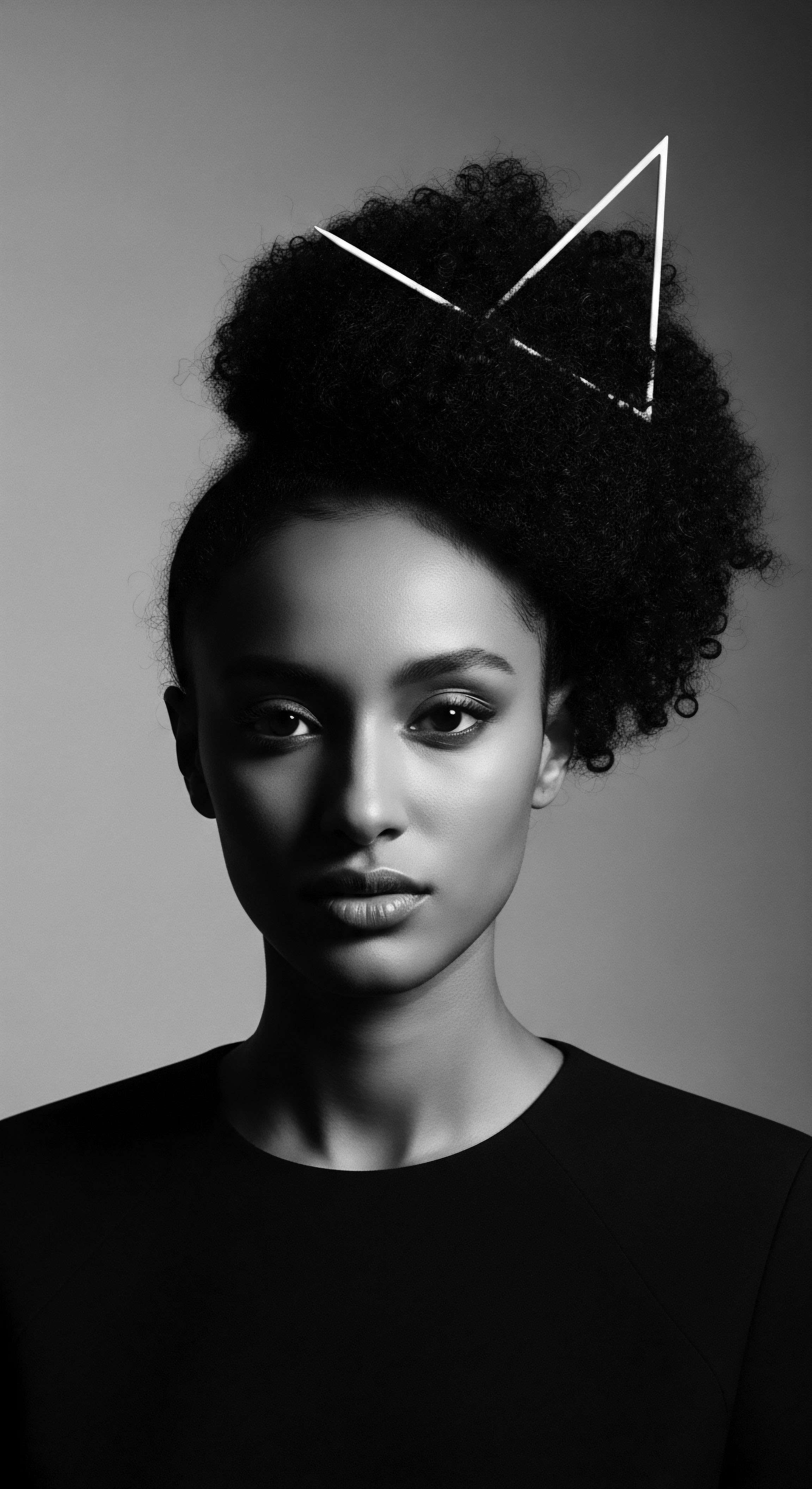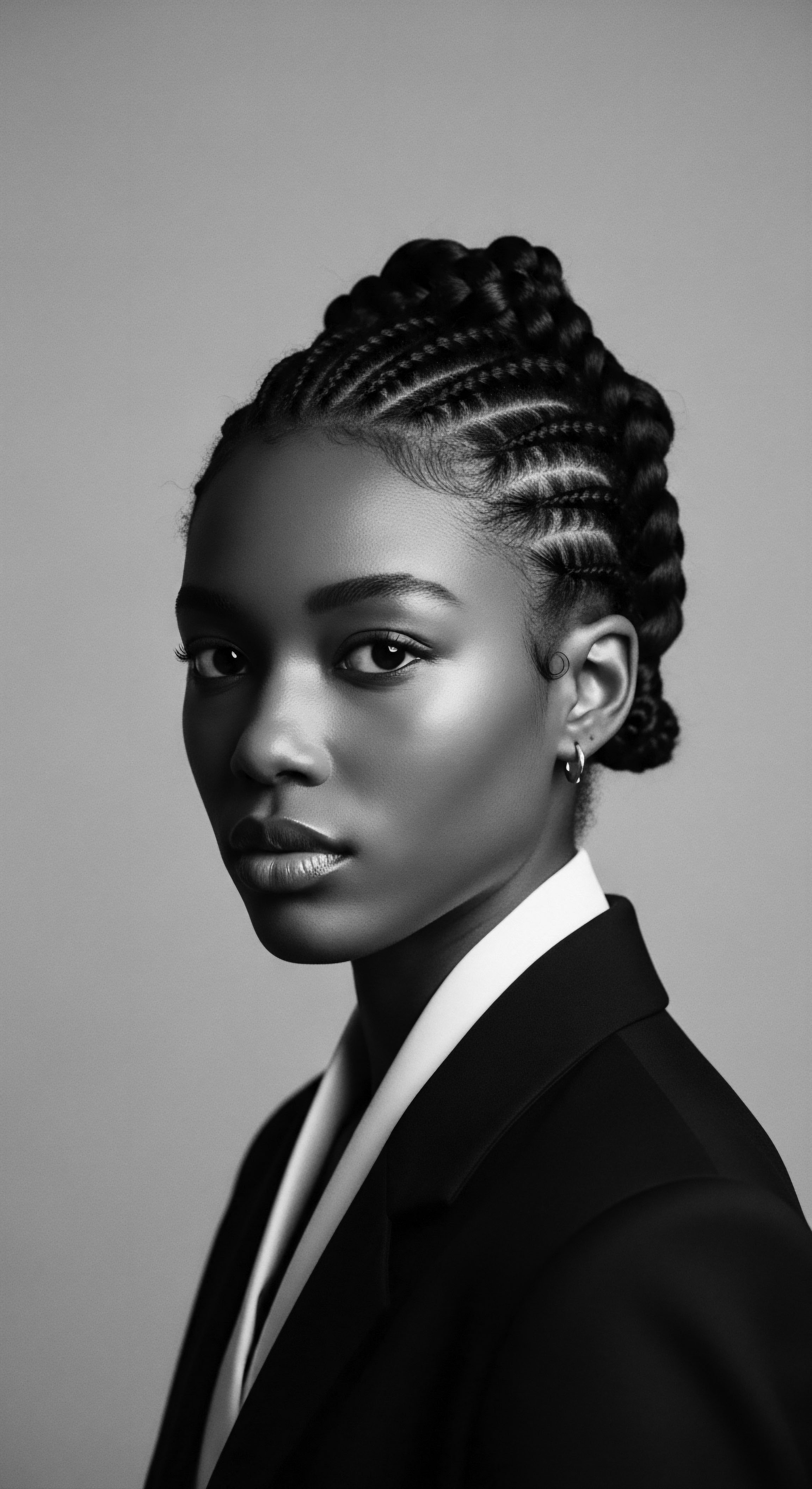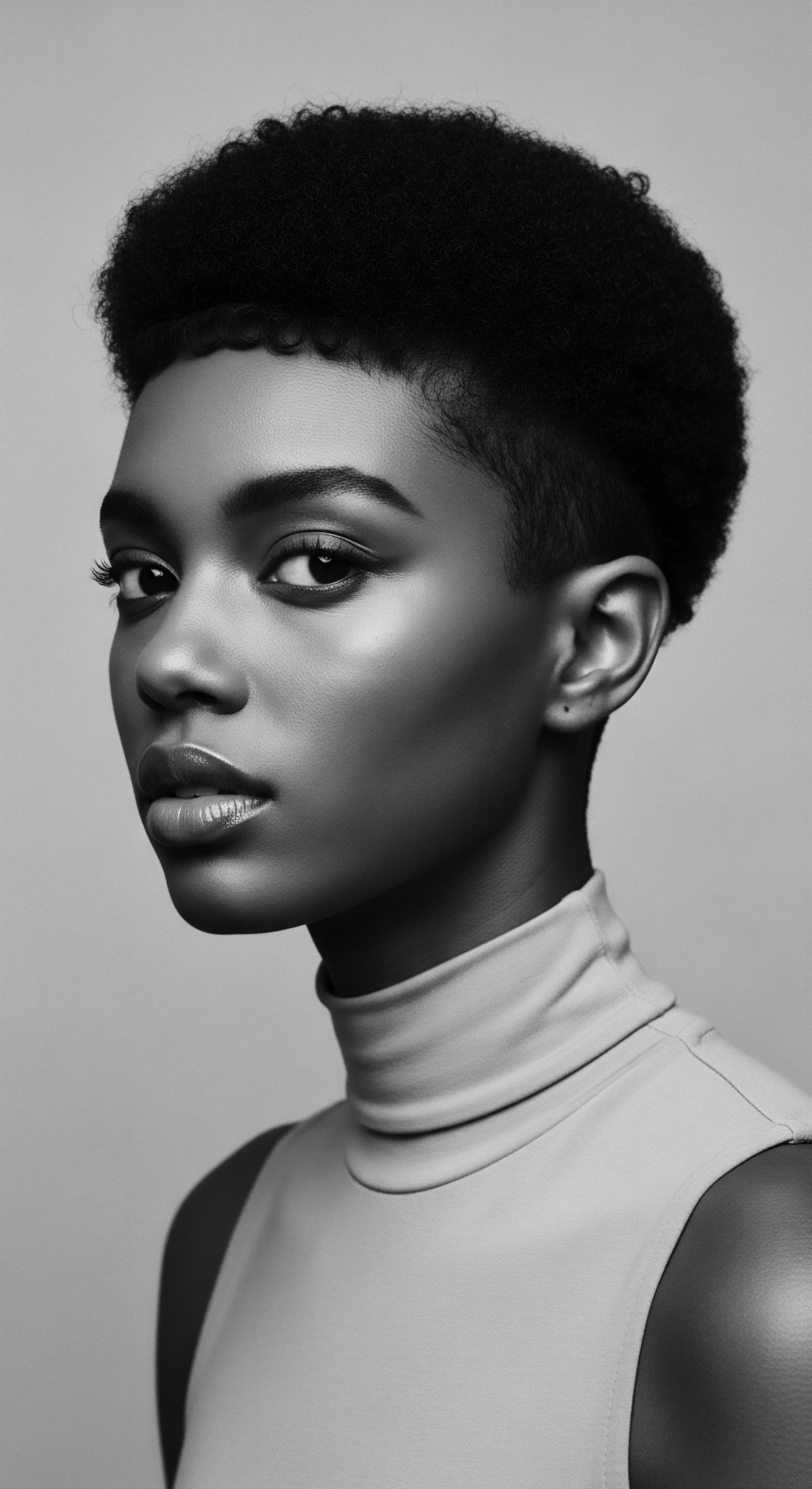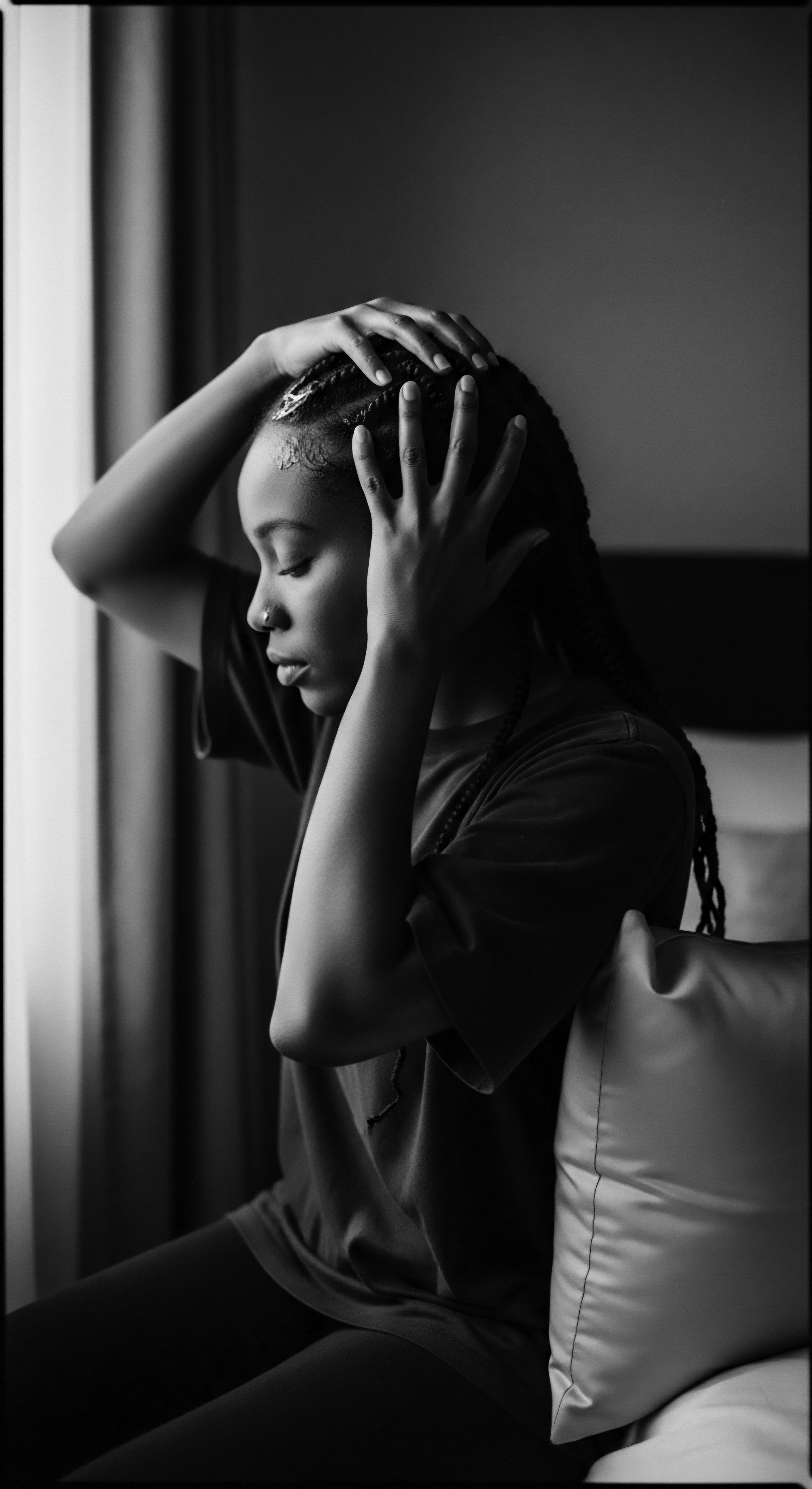
Roots
The very strands that crown our heads, particularly those with the intricate architecture of curls and coils, hold within them a profound story—a chronicle etched across millennia. It is a story not merely of biology, but of enduring heritage , of wisdom passed down through ancestral hands, and of a deep connection to the Earth’s botanical bounty. How did ancient plant care influence textured hair health? This inquiry leads us back to the source, to civilizations that understood the language of leaves, roots, and seeds long before laboratories isolated compounds or modern science dissected a single protein.
For those whose lineage traces through the rich tapestries of African and diasporic cultures, this question carries a weight of recognition, a familiar echo from a distant, yet ever-present past. Our hair, in its glorious variability, is a living archive, a testament to the ingenious, often unwritten, pharmacopoeia of our forebears. They instinctively knew that the strength, sheen, and very spirit of the strand were inextricably linked to the vibrant life force of plants.
Ancient plant care for textured hair health is a living archive of ancestral wisdom, offering insights into timeless traditions that nurtured curls and coils from the Earth’s embrace.

Hair Anatomy and the Echoes of Ancestral Understanding
To comprehend the influence of ancient plant care, one must first grasp the foundational distinctions of textured hair itself. Unlike straighter hair types, textured strands typically exhibit an elliptical or flattened cross-section, leading to the characteristic curl or coil pattern. This unique shape, coupled with fewer cuticle layers in some areas of the curve, renders textured hair more susceptible to dryness and breakage. The natural oils, known as sebum, produced by the scalp, struggle to travel down the winding shaft, leaving the ends particularly vulnerable.
Ancient practitioners, though lacking microscopes or chemical analyses, observed these very vulnerabilities. Their solutions, born from generations of empirical knowledge, aimed directly at these challenges. They did not speak of ceramides or protein bonds, yet their plant-based remedies functioned as if they did, providing lubrication, strengthening, and protective barriers.
Consider the hair follicle , the tiny organ beneath the scalp responsible for producing the hair shaft. Its health dictates the vitality of the hair itself. Ancient care practices frequently focused on scalp treatments, a testament to this intuitive understanding. The application of various plant concoctions to the scalp—whether infused oils, poultices, or rinses—aimed to stimulate circulation, cleanse without stripping, and soothe irritation.
This directly addressed the environment from which the hair sprung, creating a hospitable ground for robust growth. Many indigenous healing systems across Africa, for instance, held that the body was a microcosm of the natural world. A healthy scalp, a fertile ground, would naturally yield healthy hair, much like fertile soil yielded a bountiful crop. This holistic view, so prevalent in ancestral societies, saw hair not in isolation, but as a direct reflection of internal and external well-being, intrinsically tied to natural resources.

Classification Systems and Cultural Narratives
While modern hair typing systems, like the Andre Walker system, categorize hair from straight to coily (1A to 4C), ancient communities often possessed their own nuanced ways of describing hair, often linked to lineage , identity , or specific cultural practices . These ancestral classifications were less about numerical scales and more about inherent qualities observed over time, qualities directly influenced by the care provided. A community might speak of hair that was “strong like sisal,” referring to its resilience when properly hydrated, or “soft as kapok,” indicating a well-conditioned state. Such descriptors were often tied to the efficacy of traditional plant-based treatments.
The very lexicon of textured hair, therefore, holds whispers of ancient botanical influence. Terms like “locs,” which signify a specific natural formation, were historically maintained and enhanced with plant-derived butters and pastes, aiding the locking process while keeping the hair moisturized. In many traditions, hair wasn’t just hair; it was a map, a symbol, a spiritual conduit.
The way it was tended, the plants chosen for its care, spoke volumes about one’s clan, marital status, or spiritual dedication. This intricate system of meaning underscored the importance of not just what plants were used, but how they were incorporated into daily rituals that affirmed cultural belonging and personal identity .

Hair Growth Cycles and Ancestral Rhythms
The cyclical nature of hair growth—anagen (growth), catagen (transition), and telogen (rest)—was, without doubt, observed by ancient cultures, even if not articulated in scientific terms. They understood periods of shedding, of growth, and of stagnation. Their plant-based remedies often corresponded with these natural rhythms.
For example, tonics made from certain roots or leaves, believed to invigorate the scalp, might have been applied during times associated with new growth. Similarly, protective styles, often maintained with plant resins or oils, allowed hair to rest and minimize breakage during its telogen phase, preserving length and density.
Historical Environmental Factors and nutritional influences played a significant role in hair health and the choice of plant-based care. Communities living in arid regions would gravitate towards deeply moisturizing plant butters and oils, such as Shea Butter or argan oil , to counteract dryness. Those in more humid climes might favor astringent herbs to prevent scalp conditions.
Dietary practices, rich in plant-based nutrients, also provided an internal foundation for robust hair growth, a holistic approach rarely separated from external topical applications in ancestral wellness systems. The very idea of “food as medicine” extended to hair care, recognizing that internal health directly manifested in the strength and appearance of the hair.

Ritual
The care of textured hair, for millennia, has been far more than a routine act; it has been a sacred ritual , a communal gathering, an intimate whisper of ancestral knowledge . This deep ceremonial aspect is where the influence of ancient plant care truly comes alive, transforming simple botanical elements into potent elixirs for both hair health and spirit. These practices, honed over countless generations, were not merely cosmetic applications; they were expressions of identity, community, and reverence for the self. The choice of plant, the method of preparation, the timing of application—all were steeped in profound meaning, weaving together the tangible and the spiritual aspects of hair heritage .
Ancient plant care infused hair rituals with profound meaning, blending botanical knowledge with communal practices that sustained both strands and spirit across generations.

Protective Styling and the Roots of Resilience
Protective styles, a cornerstone of textured hair care today, possess deep ancestral roots firmly tied to ancient plant practices. Braids, twists, and various forms of coiling were not simply aesthetic choices; they were strategic defenses against environmental aggressors like sun, dust, and breakage from daily life. These styles kept the hair tucked away, reducing manipulation and preserving moisture.
Ancient plant care played a pivotal part in their efficacy and longevity. For instance, before braiding, the hair was often saturated with plant-derived oils or butters.
Consider the widespread use of shea butter (Vitellaria paradoxa) across West African cultures. Historically, its application was deeply integrated into communal life, from infancy rituals where newborns were massaged with it for skin and scalp health, to rites of passage for young women, signifying beauty, strength, and preparedness for womanhood (Akihisa et al. 2010). Its rich composition of fatty acids, vitamins A and E, and triterpenes provided natural sun protection, prevented moisture loss in arid climates, and offered anti-inflammatory benefits to the scalp.
This consistent, multi-generational application of a specific plant compound directly addressed challenges common to textured hair, such as dryness and breakage, preserving its vitality long before modern chemistry understood its precise molecular mechanisms. The butter not only lubricated the strands, making them more pliable for styling, but also formed a protective barrier, sealing in moisture and adding a natural sheen that spoke of health and careful tending.
Other traditional protective styles involved the use of plant fibers or muds mixed with botanical extracts. The Himbra Women of Namibia, for example, traditionally use an otjize mixture, a paste of ochre, butterfat, and sometimes aromatic plant extracts, on their hair and skin. This practice serves multiple purposes ❉ aesthetic, protective against the harsh desert sun, and as a natural cleanser that maintains the hair’s coiled structure and vibrancy. This is a powerful demonstration of how ancient communities utilized the immediate plant world to sustain complex protective styles, preserving hair health and cultural identity.

Natural Styling and Definitions ❉ An Ancestral Canvas
The myriad ways textured hair can be naturally styled and defined today often echo traditional methods that relied heavily on plant properties. The goal was to enhance the hair’s natural curl pattern, reduce frizz, and impart a healthy appearance. Before the advent of modern gels and creams, communities turned to mucilaginous plants—those that produce a thick, gooey substance when soaked in water.
- Okra Mucilage ❉ In parts of West Africa, the clear liquid from boiled okra pods was a known hair conditioner and detangler. The natural polymers within okra helped to define curls and provide a slip for easier manipulation, minimizing breakage during styling.
- Flaxseed Gel ❉ While not exclusive to African traditions, the use of flaxseed (Linum usitatissimum) for its hair-defining properties has ancient precedents in various cultures. The gel extracted from soaked flaxseeds offers a light hold and natural shine, helping to clump curls and reduce frizz, a valuable asset for textured hair.
- Aloe Vera ❉ Indigenous to Africa, aloe vera has been revered for its soothing and moisturizing properties for centuries. Its gel was applied directly to the scalp to alleviate irritation and condition the hair shaft, lending itself to smoother, more defined natural styles.
These methods speak to an astute understanding of how to harness the intrinsic properties of plants to achieve desired hair outcomes. The “definition” that modern products promise was, in ancestral times, often achieved through these very plant-based applications, resulting in vibrant, healthy-looking curls that resisted the elements.

The Complete Textured Hair Toolkit ❉ Beyond the Comb
The tools used in ancient hair care were often as organic and natural as the plant ingredients themselves, reflecting a symbiotic relationship between practice and resource. Before metal combs and plastic brushes, hands, sticks, and plant fibers were the primary implements. However, certain tools were specifically designed to work in conjunction with plant preparations.
| Tool Wide-Tooth Wooden Combs |
| Traditional Use and Plant Influence Crafted from local woods, these combs were often smoothed with plant oils to reduce friction. Their wide teeth were ideal for detangling hair softened and lubricated by plant butters or herbal rinses, minimizing breakage on fragile textured strands. |
| Tool Gourds and Clay Pots |
| Traditional Use and Plant Influence Used for mixing and storing plant infusions, oils, and balms. These natural vessels preserved the integrity of the botanical ingredients, ensuring their potency for hair treatments. The porous nature of clay could even enhance fermentation for some plant-based preparations. |
| Tool Plant Fibers and Leaves |
| Traditional Use and Plant Influence Certain pliable plant stems or leaves were used as natural hair ties or to section hair during elaborate styling rituals involving plant-based pastes. Some cultures used specific leaves as natural cleansing or exfoliating cloths for the scalp when applying herbal washes. |
| Tool These traditional tools underscore a deep respect for natural resources and a practical approach to hair care, intrinsically linked to the efficacy of ancient plant remedies. |
The tools were an extension of the hands that applied the plant magic, designed to distribute treatments evenly, detangle gently, and shape the hair without causing undue stress. The harmony between the tool and the botanical agent was central to the effectiveness of the entire hair care ritual, a heritage of mindful practice.

Relay
The ancient wisdom surrounding plant care for textured hair health is not a static relic of the past; it is a dynamic inheritance, a living current that flows through generations, adapting and reinterpreting itself while retaining its essential ancestral spirit . This ongoing relay of knowledge highlights the profound understanding our forebears possessed regarding the symbiotic relationship between human well-being , the natural world , and the distinctive needs of curls and coils. The depth of this influence extends beyond mere topical application, reaching into the very philosophies of wellness and self-adornment that define Black and mixed-race heritage .
The relay of ancient plant care for textured hair is an ongoing inheritance, demonstrating ancestral foresight in nurturing strands through botanical wisdom and holistic wellness philosophies.

Building Personalized Textured Hair Regimens ❉ A Historical Blueprint
Modern textured hair care often emphasizes personalized regimens, a concept that finds its parallel in ancestral practices. Ancient communities did not subscribe to a “one-size-fits-all” approach. Instead, hair care was often tailored to an individual’s specific needs, environment, and even life stage. The choice of plants and rituals was a reflection of acute observation and intuitive understanding.
For instance, in certain West African societies, the selection of plant oils and butters for hair care might vary based on age or status. A young child’s scalp, delicate and developing, might receive gentle applications of baobab oil (Adansonia digitata), known for its mild moisturizing properties. Adults engaged in strenuous outdoor labor might apply thicker, protective butters like kokum butter (Garcinia indica) or illipe butter (Shorea stenoptera) for enhanced environmental protection and moisture retention. The understanding of different hair porosities and textures, though not scientifically articulated, was nonetheless factored into these traditional regimens.
Individuals with hair that quickly lost moisture might be advised to use richer, heavier plant extracts, while those with finer strands might opt for lighter infusions. This bespoke approach, rooted in keen observation and generational experience, formed the foundation of effective, personalized hair care long before contemporary product lines existed. The emphasis was always on listening to the hair, observing its response to the natural elements, and drawing upon the immediate botanical resources to meet its requirements.

The Nighttime Sanctuary ❉ Ancestral Wisdom and Sleep Protection
The importance of nighttime hair protection, particularly for textured strands, is a concept with deep historical roots. The modern bonnet or silk scarf, while a staple today, has ancestral precedents in various forms of headwraps and coverings. These practices were not just about preserving a hairstyle; they were crucial for maintaining hair health by preventing moisture loss, reducing friction against coarser sleeping surfaces, and protecting delicate strands from tangling.
In many African traditions, covering the hair at night, or even during the day as a form of adornment and protection, was common. These coverings, often made from natural fibers, created a micro-environment for the hair that was conducive to retaining moisture. Before wrapping, plant-based preparations—light oils, herbal infusions, or the residual moisture from a previous day’s treatment—would often be applied.
This established a nighttime sanctuary for the hair, allowing plant ingredients to continue their work of conditioning and strengthening without external interference. The ritual of covering the hair before sleep also held spiritual significance in some communities, symbolizing protection, rest, and preparation for the new day, all while intrinsically caring for the physical strands.

Ingredient Deep Dives ❉ A Botanical Pharmacopoeia
The ancestral pharmacopoeia for textured hair health is incredibly rich, utilizing a diverse array of plants, each chosen for its specific properties. The efficacy of these traditional ingredients is increasingly being validated by modern scientific inquiry, bridging ancient wisdom with contemporary understanding.
- Chebe Powder (Croton zambesicus) ❉ Originating from Chadian nomadic tribes, Chebe powder is a combination of ground seeds (croton zambesicus), resin, lavender croton, and stone. Mixed with oils, it is applied to the hair to reduce breakage and retain length. Its efficacy lies in creating a protective coating that reinforces the hair shaft, a traditional method of fortifying fragile strands against external stress.
- Rhassoul Clay ❉ Sourced from the Atlas Mountains of Morocco, this volcanic clay has been used for centuries as a hair and body cleanser. Its high mineral content helps to gently cleanse the scalp and hair without stripping natural oils, leaving textured hair soft, defined, and moisturized. It effectively removes impurities while respecting the hair’s natural moisture balance.
- Fenugreek Seeds (Trigonella foenum-graecum) ❉ Used across South Asia and parts of Africa, fenugreek seeds are soaked to create a mucilaginous paste or oil infusion. Rich in proteins, nicotinic acid, and alkaloids, they are traditionally used to strengthen hair, reduce shedding, and promote growth by improving scalp health and fortifying the hair shaft.
These are but a few examples from a vast botanical library, each demonstrating a profound understanding of plant chemistry and its application to hair needs. The process often involved simple but precise preparation ❉ infusions, decoctions, poultices, or macerated oils, methods perfected over generations through trial and error.

Holistic Influences on Hair Health ❉ Beyond the Strand
The ancestral approach to hair care was rarely confined to the hair itself. It was intrinsically linked to broader holistic wellness philosophies , recognizing that hair health was a manifestation of overall physical, emotional, and spiritual well-being. This perspective underscores a central tenet of heritage ❉ that human beings are part of a larger interconnected ecosystem.
Diet, for instance, played a significant role. Traditional diets rich in local, nutrient-dense plants provided the internal building blocks for healthy hair. Herbs used for internal cleansing or invigorating the body were often believed to indirectly benefit hair vitality.
Stress, too, was understood to impact the body as a whole, including hair. Relaxation techniques, communal support systems, and spiritual practices were all part of a holistic framework that contributed to a balanced state, indirectly supporting hair health.
This comprehensive understanding of health, where the external application of plant care was harmonized with internal well-being and community support, is a powerful legacy. It encourages us to look beyond the immediate strand and consider the full spectrum of influences, much as our ancestors did, affirming that true radiance emanates from a place of deep, interconnected wellness . The continuous relay of this wisdom speaks to a profound respect for the body as a temple and for the Earth as its provider, a powerful message for contemporary hair care.

Reflection
Our exploration of how ancient plant care shaped the vitality of textured hair health is a testament to an unbroken lineage of wisdom, a living echo across time. From the nuanced understanding of a coil’s unique architecture to the communal rituals that transformed plant compounds into expressions of identity and resilience , the influence of ancestral botanical practices remains indelibly etched upon the story of textured hair. We find ourselves standing on the shoulders of giants—those who, with hands rooted in the soil and hearts attuned to nature’s rhythms, pioneered a holistic approach to hair care that transcends fleeting trends.
This journey through Textured Hair Heritage reveals that the “Soul of a Strand” is not just a poetic notion; it is a palpable truth woven into the very fabric of our being. Each curl, each coil, each strand, carries the memory of resilience, the legacy of ingenious adaptation, and the quiet power of ancestral hands. As we continue to unravel the complexities of our hair, drawing upon both scientific discovery and the profound intuition of our forebears, we honor this legacy.
The future of textured hair care, in its most authentic form, will always involve a respectful dialogue with the past, recognizing that the Earth’s enduring gifts, guided by ancient wisdom, offer timeless pathways to radiant health and self-acceptance. The work of understanding our hair is, in essence, the work of understanding ourselves, our history, and our enduring connection to the very roots of existence.

References
- Akihisa, T. et al. (2010). Triterpene alcohol and fatty acid composition of shea butter from various geographical regions of Africa. Journal of Oleo Science, 59(1), 1-13.
- Alkhateeb, A. (2019). African Hair ❉ Ancient History, Cultural Identity, and Contemporary Practices. University of California Press.
- Diop, C. A. (1974). The African Origin of Civilization ❉ Myth or Reality. Lawrence Hill Books.
- Guerriero, G. et al. (2018). Rhassoul clay ❉ Chemical characterization and cosmetic usage. Applied Clay Science, 153, 169-178.
- Mbembe, A. (2017). Critique of Black Reason. Duke University Press.
- Oyelude, D. P. (2014). African Traditional Medicine ❉ A Cultural & Historical Perspective. University Press of Ibadan.
- Thapar, R. (2002). Early India ❉ From the Origins to AD 1300. University of California Press.
